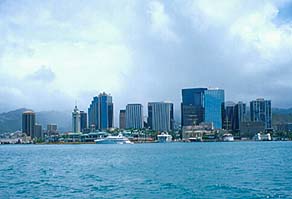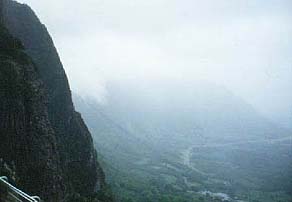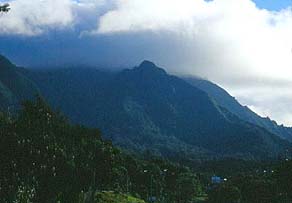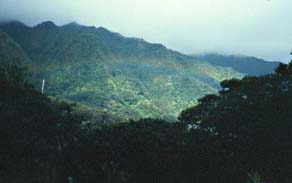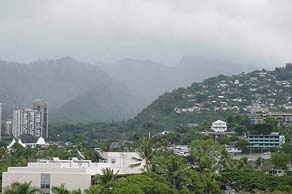 |
 |
 |
|||||||||||||||||||||
|
|
|
|
|
|
|
|
|
||||||||||||||||
|
|
|||||||||||||||||||||||
| |
|
|
|
|
|
"I know there are so many wind and rain names to describe their different feelings, or just the density or the touch or the look---a little bit of fog and mist," says Kalani. "It's amazing to think of the rain in terms of feeling, like that prickly point of rain, or that light drizzle that comes when you visit a place; or when you’re getting home, the light drizzle of greeting. People speak of it a lot that way still, and I’m just glad I’ve also learned it from experience." Nu‘uanu is a cool place, but because the mountains descend low in the back, Nu‘uanu is not as wet as some neighboring valleys where the peaks of the Ko‘olaus squeeze even more moisture from the trade winds Nonetheless, like any other place in the Hawaiian Islands, Nu‘uanu has distinct and personal rains.
|
||
|
|
||
|
|
|
|
"Here at the Pali Lookout we can see dramatically how the trade winds and clouds come over the islands and intercept the mountains" Stephen explains. "The clouds are full of water, and when they hit the mountains they start to uplift and condense. That the Ko‘olau mountains run almost perpendicular to the prevailing trade winds, some call this an accident of nature. "But in Hawaiian mythology, the islands were created to capture the clouds. It’s intriguing that we use the term ahupua‘a. The word pua‘a associated with the pig, but it’s also the name for clouds. 'Pua‘a' refers to the types of clouds that gather on the mountain peaks. So some of us feel that the term ahupua‘a--'pig altar'--has a much deeper significance: that the altar is really the mountains and the pua‘a is really the clouds."
|
|
|
|
"And in the Hawaiian mythology, the origin of the islands was the mating of Father Sky (Wakea) and Mother Earth (Papa). And there you see it, Father Sky in the form of the clouds descending on Mother Earth. And very graphically told in the Hawaiian oral or unwritten literature is that this is actually the lovemaking between Father Sky and Mother Earth. And in their passion the semen is released in the form of water, which then fertilizes the earth and from which all life form emerges. "So it’s a very poetic, sexually liberated view of the gods and the origin of life. In their lovemaking, water issues forth, and flows down the mountains in the waterfalls and streams. From that and the ancient mythology the taro plant grew. From the taro came the first Hawaiian. They’re intimately tied in this ‘ohana, family, union between the gods, the spirits, the land, the animals, and the humans. It’s a great story and one that deserves to be told."
|
|
|
|
|
Ki‘owao and Wa‘ahila are brother and sister rains that frequent Nu‘uanu and Manoa valleys. Ki‘owao is a cool, misty rain, and Wa‘ahila is a" far-reaching valley rain that goes to Honolulu Harbor." The story of these two rains, as told by Carol Silva (1991), is summarized here. Ka-ua-ki‘owao and Ka-ua-Wa‘ahila were twin children born to Kaha‘akea, a chief who lived at Mount Ka‘ala of the Wai‘anae range on O‘ahu. Their mother died giving birth to them, and her relatives, realizing her great love for her children, performed certain rites that dedicated her as their ‘aumakua, or spiritual guardian, with special powers that would help her assist and protect them. Chief Kaha‘akea loved his children very much, but knew he needed help looking after them. So he chose a woman named Hawea to be their stepmother. But Hawea did not take kindly to these stepchildren. She had a child of her own already, a dull and deformed boy who was brightly outshone by the beautiful and intelligent twins of Kaha‘akea. Hawea quickly came to detest the twins. In front of Kaha‘akea, she was kind and loving towards them, but behind his back, she was extremely hateful and cruel.
|
|
|
||
|
Many years passed, and Chief Kaha‘akea had to go to Hawai‘i island for a long while, leaving the children in Hawea's care. Once he was gone, Hawea denied the twins food, water and clothing. She enjoyed inflicting physical and emotional pain on them. But their ‘aumakua, the guardian spirit of her mother, recognized their danger and helped them flee from Hawea. She led them to a hiding place on Konahuanui. But it wasn't hard for Hawea to find them, because she knew that rainbows would appear wherever the children stayed. It was a privilege that accompanied their high birth, but which now caused their undoing. When Hawea discovered their hiding place, the spirit of their mother led them away and hid them amongst the waterfalls at the head of Manoa Valley. But again the rainbows pointed out their hiding place.
|
|
|
|
|
When Hawea found the children, she beat them and sent them home for more punishment. But then, as she wandered ahead of them, the spirit of their mother showed them a small cave where they could hide. There they set up a household and planted crops. Hawea waited and waited, and when they did not return, went and descended upon them with wrath, finding their secret home and driving them out of it. She uprooted their crops and returned to Mt. Ka‘ala, but the children once again were guided to another hiding place. Chief Kaha‘akea returned and quickly learned of all that had happened. Realizing he was ultimately responsible for the ill treatment of his children, as he had entrusted them into the care of Hawea, he killed Hawea and then took his own life. Ka-ua-Ki‘owao and Ka-ua-Wa‘ahila eventually returned to Mt. Ka‘ala, but they often return to visit the upper reaches of Nu‘uanu and Manoa valleys in the form of the cool, misty rain known as the Ki‘owao, and the heavier passing rain known as the Wa‘ahila.
|
|
|
|
|
The rains of Nu‘uanu account for the Forest cover there.
|
||
|
|
||
| |
| |
|
|
 |
| Nu‘uanu Home | Map Library | Site Map | Hawaiian Islands Home | Pacific Worlds Home |
|
|
|||
| Copyright 2003 Pacific Worlds & Associates • Usage Policy • Webmaster |
|||

